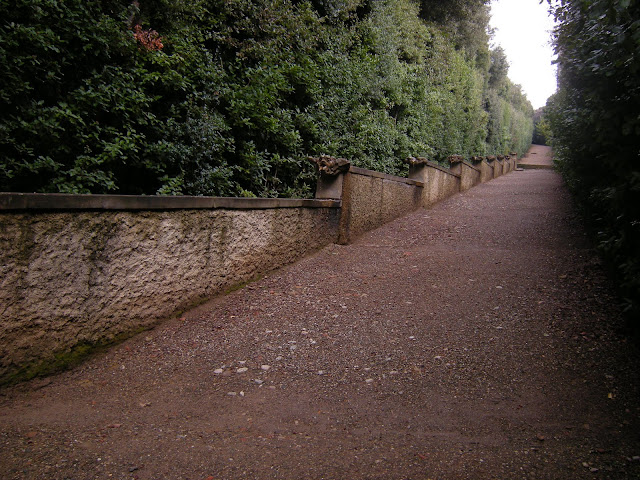-The Bird GardenThe ideal entrance of the second axis is called the Bird Garden or "Uccellare" ("Uccellare" means to hunt small birds), located on higher ground and crossed by the Grand Boulevard.
This large meadow is surrounded by oaks and cypresses and it marks the border with the western part of the garden. At the center is decorated with a broken column, while on the one hand there is one of the few contemporary works of the garden: a monumental bronze head by Igor Mitoraj, remained in the garden after the exhibition in 2002. From here you can enjoy a stunning view of neighborhood Oltrarno, beyond the house of the Meridian.
- The Garden of Pegasus
Below the Bird Garden, crossed by zig-zag paths, lies the so-called Garden of the Pegasus, a hilly slope who brings back to the level of the palace, especially in front of the square covered with gravel of the Meridian building. This area owes its name to the marble sculpture of Pegasus, by Aristodemo Costoli 1865. There are other statues and a large pool of gray granite. The large trees that stand isolated and asymmetric remember the taste of the english garden.
The Art of Garden Design in Italy
Tour of The Italian Gardens
The Renaissance of Italian Gardens
-The Grand Boulevard
The Grand Boulevard (Viottolone) is a wide avenue in steep descent, flanked by two rows of cypress trees planted in 1637, and decorated with numerous beautiful statues, which marks the secondary axis (the six-eighteenth-century south-west) of the garden. The statues, placed symmetrically close to the crossroads with the three cross paths, they are both ancient (Roman) and of recent construction, mainly eighteenth century.
The area to the left of the avenue, once a maze, today has the fascinating serpentine road. In this area remains the central basin of the maze, now surrounded by an elliptical bed. The right side was dedicated to hunting and there is also the walled garden. On both sides of the avenue running two galleries straight suggestively surrounded by vegetation.
The beginning of the Grand Boulevard from the Bird Garden is marked by two statues known as the Greek Tyrannicides, before a backdrop of cypress and laurel hedges. Only the torsos came from ancient statues. The Alley is then cut by three side streets that create six compartments of the garden.
-The first cross-street
The first cross street is an oak pergola forming two tunnels with low stone seats on the sides. Before arriving at the main driveway, the way is marked by two statues; in perspective on the left there is a pool surrounded by an elliptical flower bed, which was the center of one of the labyrinths of this part of the garden.
At the junction with Boulevard, four statues were placed on each corner, all by Giovanni Caccini: Prudence, Aesculapius and Hippolytus dying (from Polyclitus), Autumn and Hygeia. Further, on the right is the Ocean Fountain (it is not the most famous fountain in the Isolotto of Boboli, by Giambologna). This smaller fountain depicts a young man at whose foot is a dolphin who pours water.
-The second cross-street
The second cross street intersects the Avenue at an intersection with three Roman statues, a Senator, a Bacchus and a bald philosopher, while a fourth statue of Andromeda is of the eighteenth century. Down the left, at the cross street near the city walls, we have the perspective view of the colossal bust of Jupiter Olympian, attributed to Giambologna (1560), on a sandstone. Beside the statue is also the curious "fountain of Mostaccini" by Romolo del Tadda (1619-1621), consisting of a series of small pools on different terraces connected by canals and masks who pay the water from one level to the bottom.
-The third cross-street
The third cross-street is on the south-west, from the intersection with the Avenue, and it branches in numerous, complicate and intertwined paths leading to the final segment of the garden. At the intersection of the boulevards, boxtrees hedges designe four exedras in which are placed many statues: Aesculapius, Andromeda, Ninfa and Modesty. To these must be added the neighboring groups of players, according to the taste of eighteenth-century for peasants and commoners themes.
the Bird Garden
The Viottolone from the Bird Garden
romantic view of the Great Boulevard
the Viottolone at sunset
-Various statues of the Viottolone:
the pergola
The second cross-street:
the colossal bust of Zeus
GIAMBOLOGNA An Exhibition of Sculpture By the Master and His Followers, From the Collection of Michael Hall Esq.
Giambologna tra Firenze e l'Europa: Atti del convegno internazionale, Firenze, Istituto universitario olandese di storia dell'arte (Italia e i Paesi Bassi) (Italian Edition)
GIAMBOLOGNA, 1529-1608, Sculptor to the Medici. Aug.-Sept. 1978. Catalogue edited by Charles Avery and Anthony Radcliffe.
The Animals of Giambologna (Great Masterpieces)

























No comments:
Post a Comment